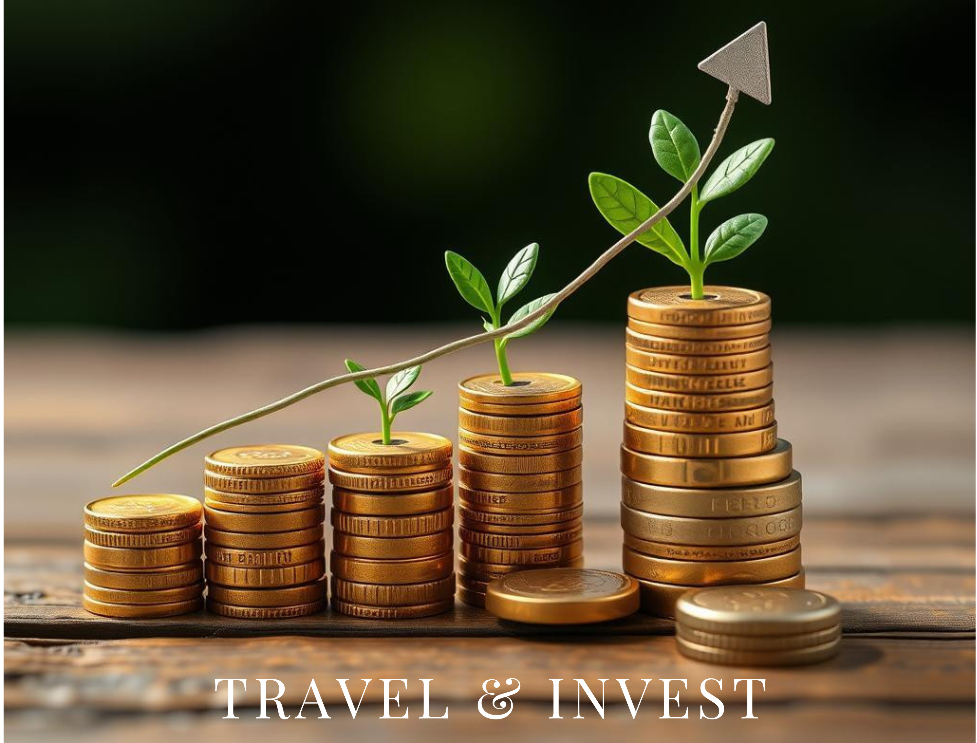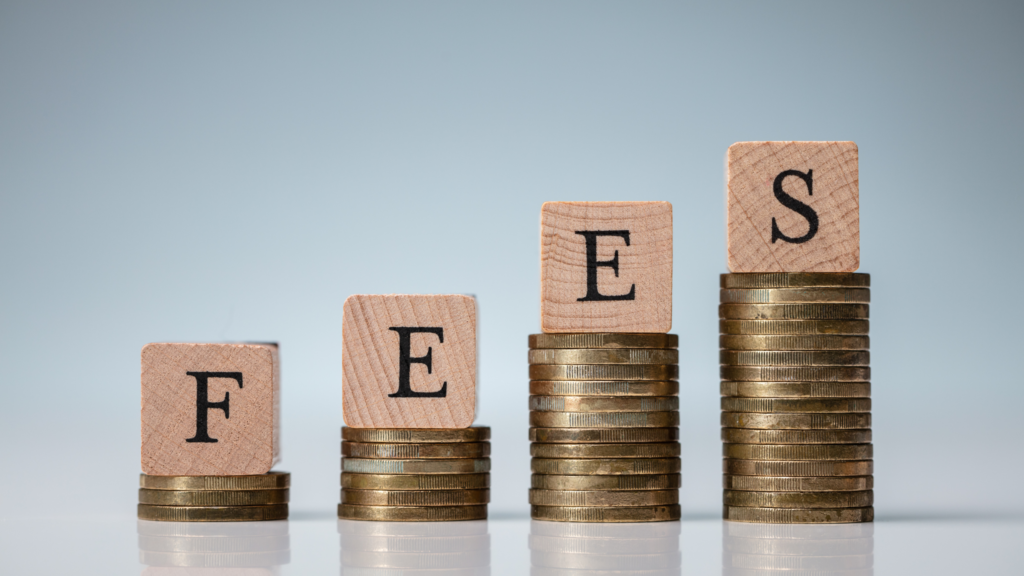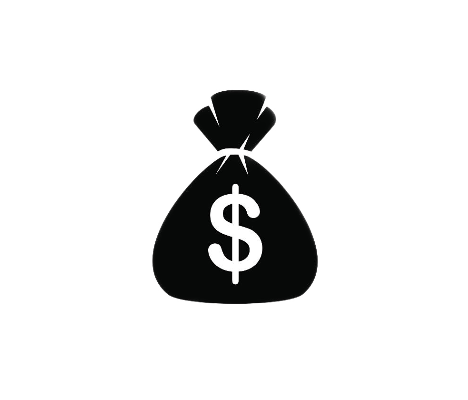![Hero Image for Investment for Beginners: Start Your Portfolio with Just 100 Euros [2025 Guide]](https://travelandinvest.com/wp-content/uploads/2025/04/164c0673-bde5-4bad-b6c5-43b14b13b8df-1024x585.png)
Many people think they need a lot of money to start investing. The truth is you can begin with just a small amount. A monthly investment of €100 could grow to €200,000 over 30 years at an average 10% return rate. You could even build close to €400,000 by investing €200 each month during the same period.
We created a detailed guide to help you start investing, whatever your initial amount. ETFs (Exchange-Traded Funds) make a great starting point. A single purchase lets you invest in about 1,500 stocks across 23 developed countries. These investments come with low fees – total expense ratios range between 0.03% and 0.8%.
This piece shows you everything about starting your investment experience with €100. You’ll learn how to pick the right investment vehicles and build a balanced portfolio that grows steadily.
Why Start Investing with Just 100 Euros
Many people think investing is only for the wealthy. This belief stops countless people from building their financial security. The reality? You don’t need thousands of euros to start investing. Even €100 (or even less) can put you on the path to financial growth.
The power of starting small
Small investments can bring surprising benefits. Starting with €100 lets you learn investing basics without risking too much money. You can build experience and confidence as your money grows.
Here’s something interesting: putting away €100 each month could grow to about €6,949 in 5 years, €16,247 in 10 years, and €45,344 in 20 years. The best part? Out of that €45,344, only €24,000 would be your contributions—the other €21,344 would be pure profit.
Small investments give you room to experiment. You can try different strategies without risking large amounts. On top of that, it helps to put in the same amount each month to balance market ups and downs. This method, called dollar-cost averaging, takes emotion out of your investment decisions.
Professor Mary Pieterse-Bloem from Erasmus School of Economics showed small investments’ potential through an interesting experiment. Her research revealed that €100 in a savings account from 1960 would be worth about €1,500 today. All the same, that same money in stocks would have earned substantially more over time.

How compound interest works in your favor
Albert Einstein reportedly called compound interest “the eighth wonder of the world,” and with good reason. Compound interest means earning interest on your interest—creating a snowball effect that builds wealth over time.
The process is simple: Your money earns returns on your original investment. By reinvesting these returns, you earn money on both your first investment and previous returns. This creates growth that speeds up over time.
Time matters more than the amount you invest when it comes to compound interest. The earlier you begin, even with small amounts, the more you can potentially earn. Each reinvested return creates its own returns, leading to a ripple effect.
Take a 5% annual return investment. It doesn’t just add 5% of your first investment yearly. Instead, it adds 5% of your growing balance, which includes all previous years’ gains. Then the returns start to multiply the longer you stay invested.
This explains why experts often say “time in the market is more important than timing the market”. Research shows that putting money in the S&P500 and waiting 20 years usually beats actively managed portfolios.

Overcoming the ‘not enough money’ mindset
People often avoid investing because they think small amounts won’t matter. This “not enough money” mindset blocks wealth building. Several factors create this mental barrier:
- Lack of thinking: The belief that there’s never enough money leads to fear, anxiety, and poor money choices, like avoiding investments.
- Fear of financial failure: Losing money scares potential investors away. Note that setbacks help you learn rather than define your success.
- Misunderstanding investment accessibility: Most people think investing needs big money, not knowing modern platforms accept small amounts.

You can break these barriers by accepting that investing isn’t just for high earners. Online trading platforms let you start with just a few euros. Your point of view about money should change from scarcity to abundance—seeing it as a tool to create a good life, not just survive.
The best way to beat the “not enough money” mindset is to take that first step. Investing even a small amount helps you break mental barriers and build regular investing habits. Your starting amount matters nowhere near as much as staying consistent and patient.
Mary Pieterse-Bloem’s research proves that stock investments earn substantially more than savings accounts, even with market swings.
Starting small today beats waiting until you have “enough” to begin.
Building Your Financial Foundation First
Building a solid financial foundation is vital before you start investing. Your investment trip needs protection from unexpected disruptions, even if you start with just €100. Let’s look at two key pillars you need to set up before you put your money into investments.
Creating an emergency fund
Your emergency fund works as a financial safety net that protects you when life throws unexpected events your way. This dedicated savings reserve helps you handle unplanned expenses like medical emergencies, car repairs, home maintenance issues, or even sudden job loss. You might have to sell investments at a loss or take on high-interest debt during tough times without this buffer.
Financial experts suggest saving 3 to 6 months’ worth of living expenses in your emergency fund. This amount gives you enough protection against spending shocks (unexpected expenses) and income shocks (job loss or reduced income). To name just one example, see if your monthly expenses are €3,000 – your emergency fund target should range between €9,000 and €18,000.
Start by saving enough to cover spending shocks—about half a month’s expenses or €2,000, whichever is greater. You can build toward the full 3-6 months target once you hit this first milestone.
These funds need to stay in highly liquid accounts that you can access quickly since emergencies don’t announce themselves:
- High-yield savings accounts
- Money market accounts
These options might give lower returns than investments, but they provide the liquidity and safety your emergency fund needs. Vanguard’s advice states, “You want this money to stay safe and liquid. It should not be invested in stocks or even bonds, where it may be subject to market risk”.
Setting up automatic contributions from your paycheck helps build your emergency fund steadily. Small amounts add up over time. Unexpected windfalls like tax refunds or bonuses can speed up your progress.

Paying off high-interest debt
Getting rid of high-interest debt, especially credit card balances, is your second foundation pillar. Financial experts point out that “There is no investment strategy anywhere that pays off as well as, or with less risk than, merely paying off all high interest debt you may have”.
Credit cards often carry interest rates around 24.20% as of March 2025 —this is a big deal. Each euro used to pay down credit card debt “earns” you that interest rate in avoided costs, giving you a guaranteed return that’s nowhere near what most investments can offer.
Most people should focus on paying down any debt with an interest rate of 6% or higher before they start investing. Additional funds can go into investments after eliminating high-interest debt.
Here are some strategic approaches if you have substantial credit card debt:
- Target highest rates first: Clear debts with the highest interest rates first while making minimum payments on others.
- Balance transfers: Move balances to a card with a lower interest rate—some offer promotional 0% periods of 6-18 months.
- Debt consolidation: A consolidation loan with a lower interest rate can simplify payments and cut overall interest costs.
Getting rid of high-interest debt is essential before you begin your investment trip. This approach builds a stable financial foundation that keeps your future investments safe from emergency liquidation or debt payments.
These two financial pillars will position you perfectly to start your investment journey with confidence, even with modest amounts like €100.
Best Investment Options for Beginners in 2025
Your financial foundation looks solid. Let’s take a closer look at investment options that make your euros work harder. Technology and new financial products have made investing more available than ever to beginners in 2025.
ETFs: The beginner-friendly investment
Exchange-Traded Funds (ETFs) are the perfect starting point for new investors. These investment vehicles work like baskets filled with multiple securities—stocks, bonds, or other assets—that you can buy in one transaction. Most ETFs track an index and automatically follow how a group of companies performs instead of just one stock.
ETFs give you instant diversification, which experts call “the only free lunch in the investing world”. Your money spreads across different companies or industries, which reduces the risk of any single investment hurting your portfolio by a lot.
ETFs also come with really low fees. They are passively managed, which means they just track an index without constant buying and selling. This keeps fees incredibly low—some ETFs charge just 0.03% annually – like SPDR S&P 500 UCITS ETF (Acc). That’s only €3.00 for every €10,000 you invest.
Investing for beginners is easier when is based on broad-market ETFs like those tracking the MSCI World/FTSE All-World Index. This index invests in over 1,500 companies worldwide across industrialized countries. These ETFs are a great way to spread your money across different countries and sectors.
Trading platforms worth checking out
Online trading platforms have changed how people invest. Anyone can now enter the market with small amounts of money. These user-friendly platforms let you make automated contributions, round up spare change, or buy partial shares with a few taps on your phone.
Here are some great options:
Interactive Brokers Europe gives you access to a wide range of global markets with low fees and fractional share trading. It’s ideal for those who want a more advanced platform with the flexibility to scale their investments over time. Their user-friendly mobile app makes it easy to start small and grow.
Trading212 is a favourite among beginners and seasoned investors alike. You can invest commission-free in fractional shares and ETFs, and the app is clean, simple, and intuitive. Automated investing features and educational tools also make it beginner-friendly.
LightYear brings a fresh take to investing with a focus on transparency and zero trading fees on core features. It supports fractional shares, and its clear cost breakdown and slick interface make it appealing for users across Europe.
Note for UK investors: The two most popular platforms in the UK for online brokers are Trading212 and Freetrade, both of which offer commission-free investing and support for fractional shares.
Fractional shares: Buying pieces of expensive stocks
Fractional shares have changed the game. You can now own less than one whole share of a company. This means expensive stocks are now available to everyone, whatever their budget.
You can now invest based on how much money you want to spend rather than buying whole shares. To name just one example, a stock might cost €1000, but with fractional shares, you could invest €100 and own about 0.1 shares.
Most brokerages offer fractional shares with low minimums. They let you buy pieces of any S&P 500 company starting at €10.
This has opened up the market to more people, making it easier to build a custom, diverse portfolio. Even as a partial share owner, you’ll get your share of dividend payments from companies that offer them.
Savings accounts and bonds: Lower risk options
Some beginners prefer stability over growth. Here are some low-risk options that work well.
High-yield savings accounts offer better interest than traditional bank rates while keeping your money safe and accessible. In the EU, national deposit guarantee schemes typically protect up to €100,000 per depositor per bank.
Money market funds invest in short-term, stable financial instruments such as government paper and term deposits. They usually offer higher returns than savings accounts while remaining liquid and relatively safe.
Fixed-term deposits (similar to U.S. certificates of deposit) offer guaranteed interest rates for set periods, usually between six months and five years. They tend to yield more than savings accounts and are also covered by national deposit guarantees.
Government bonds from stable countries, like German Bunds or French sovereign bonds, are considered low-risk. While their returns may be modest, they help preserve capital during market turbulence.
Your best investment strategy depends on your goals, timeline, and comfort with risk. Most experts suggest mixing several of these options to build a balanced portfolio.
Step-by-Step Guide to Making Your First Investment
Starting to invest might seem scary at first. A well-planned approach will show you that making your first investment isn’t as complex as you might think. Let me guide you through everything you need to know – from picking a platform to automating your investments.
Choosing the right investment platform
Your investment success starts with picking the right platform. Here’s what matters most when you look at different options:
User-friendly interface – Pick platforms with clean, easy-to-use designs that help you navigate without confusion, especially if you’re new to investing.
Fees and costs – Look at platform fees (look for service/custody/withdrawal charges), trading fees, and foreign exchange fees. Many online brokers don’t require minimum deposits now, which makes it easier to start small.
Educational resources – Choose platforms that give you tutorials, webinars, and learning materials to help build your investment knowledge.
Mobile accessibility – The ever-changing world needs a good mobile app so you can check markets and handle your investments anywhere.
Setting up your account
After picking your platform, here’s what you’ll need to do:
- Account creation – Pick a user ID and password, then choose an account type that works for you (brokerage/invest account, retirement account, etc.)
- Personal information – Get your ID ready (Social Security number/Passport)
- Bank linking – Add your checking or savings account with your bank’s IBAN or account number. Some brokers allow for free deposits by debit/credit card (for the first 2-3 deposits or for the first €2000)
- Verification process – Follow the identity checks your platform need. You will need to upload a copy of your ID or Passport as well as a utility bill copy for address verification.
Making your first purchase
Now that your account has money, here’s how to start investing:
- Do a bit of research – ETFs and index funds are great beginner picks because they help spread out your risk.
- Find the right symbol – Every fund or stock has a short code called a ticker symbol. Just type it in to see more details. You can find extra info about each ETF on this url, or your can use Google Finance for information about individual stocks.
- Pick how you want to buy – For your first buy order, stick with a market order. That means you’ll buy at the current price.
- Double-check and confirm – Take a moment to review everything before you hit “buy.” It only takes a second, and it’s worth it.
Setting up automatic investments
Automated investing helps build wealth steadily.
Schedule regular contributions – Set up regular transfers from your bank to your investment account. Try to match these with your payday.
Dollar-cost averaging (DCA) – Regular fixed investments help reduce market risk and keep emotions out of your decisions.
Reinvest dividends – Turn on automatic dividend reinvestment to help your money grow faster.
Start small – Begin with what fits your budget, even €100, and add more as you earn more.
Creating a Balanced Portfolio with Limited Funds
You don’t need thousands of euros to build a balanced portfolio with proper diversification. A mere €100 can help you create an investment mix that spreads risk and maintains growth potential.
The 100 Euro diversification strategy
Smart asset allocation among different investment types forms the foundation of successful investing with limited funds. Your €100 can be divided into portions that span several asset classes. Many investors opt for a 40/60 mix of low-risk/high-risk assets or any combination that matches their risk tolerance.
Here’s a simple strategy to get started:
- 60% in a broad market ETF tracking global stocks
- 30% in bond ETFs or fixed-income investments
- 10% in alternative assets or cash equivalents
This basic allocation ensures that no single investment controls your portfolio’s performance. High-performing investments can offset lower-performing ones, which allows your portfolio to average out to an overall profit.
Online trading platforms now let you build a diversified portfolio with as little as €10. These services give you ownership of fractional shares from multiple companies at once.
Balancing risk and potential returns
The risk-return relationship stands as a basic investing principle – higher potential returns usually come with greater risk. A diversified portfolio helps different assets respond uniquely to market changes, which minimizes overall risk.
Diversification reduces unsystematic risk that affects individual companies. The best results come from assets with low or negative correlations. Your portfolio stays stable when rising assets counterbalance falling ones.
Regular portfolio rebalancing helps maintain your target allocation as your investment grows. Market movements naturally shift your asset proportions over time and might increase exposure to certain investments.
Your original €100 investment should grow through additional contributions and market returns. The focus on risk balancing through diversification remains essential whatever the size of your portfolio.
Common Mistakes Beginners Should Avoid
Smart investors make mistakes too, but spotting common pitfalls early saves beginners money and frustration. You’ll set yourself up for long-term success in your investment experience by steering clear of these typical errors.
Trying to time the market
New investors often think they can predict market movements and buy low while selling high. The reality is that accurate market timing is almost impossible. Studies show that your returns could drop by half if you miss just the 10 best days over 30 years. The numbers look even worse – missing the best 30 days would slash returns by 83%.
The best strategy is to invest steadily whatever the market conditions. The data shows that even poorly timed investments beat keeping money in cash investments.
Checking your investments too frequently
New investors often feel compelled to watch their portfolio constantly. This frequent checking leads to emotional choices and quick reactions when markets move normally.
Money experts suggest you look at your investments every quarter instead of daily or weekly. Quarterly reviews show clearer trends and help reduce stress from short-term market swings. Most successful investors stick to yearly complete reviews.
Forgetting about fees and taxes

Small percentage changes affect your investment growth over time. Even tiny fees add up with your returns and eat into both the fee amount and future growth potential.
Investment taxes can take a big bite out of net returns. The government wants its share from both investment income and realized capital gains. Here’s how to keep taxes low:
- Hold investments longer than a year to get better long-term capital gains rates
- Use tax-loss harvesting to balance gains with losses
- Keep tax-inefficient investments in tax-advantaged accounts
Neglecting to increase investments over time
Starting with €100 shows initiative, but keeping the same amount forever limits your growth potential. Your investment amounts should grow as your income rises.
Regular additions to your investment portfolio improve long-term growth and help smooth out market swings through dollar-cost averaging.
Conclusion
A €100 investment might seem small, but it marks the beginning of your wealth-building experience. Smart diversification, regular contributions, and patience will help your minimal investments grow over time.
Investment success depends on consistency rather than size. Your balanced portfolio of ETFs and automated monthly contributions will help navigate market fluctuations while building wealth. Many beginners feel tempted to time the market, but following your investment strategy through market cycles produces better outcomes.
Building wealth needs patience and discipline. Knowledge about emergency funds, debt management, and investment vehicles will help you make sound decisions. Today’s €100 investment is your first step toward financial growth. Watch it thrive through compound interest and strategic management.
Disclaimer: The information provided in this article is for educational and informational purposes only and should not be construed as financial advice. Investing in the stock market carries risks, including the potential loss of principal. Before making any investment decisions, it is essential to conduct thorough research and consider consulting with a qualified financial advisor. Additionally, please note that investment platforms and brokers may have specific terms, conditions, and fees that should be carefully reviewed before opening an account or executing trades.

Follow Us on Social Media
Discover More






Thank you for sharing, very helpful and insightful article for new investors!